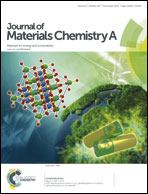Facile ultrasonic deposition of SnO2 nanoparticles on TiO2 nanotube films for enhanced photoelectrochemical performances
Abstract
After a self-organized TiO2 nanotube film on a Ti substrate was fabricated through anodic oxidation, SnO2 nanoparticles were deposited on the film by a facile ultrasonic assisted deposition method. The photoelectrochemical performances of the prepared SnO2–TiO2 nanotube composite films were evaluated by measuring their incident photon to current conversion efficiencies, transient photocurrents, and photopotentials. The results demonstrated that the deposited SnO2 nanoparticles could greatly enhance the photoelectrochemical performance of the TiO2 nanotube film. The SnO2–TiO2 nanotube composite films were highly sensitive to white light illumination. A maximum incident photon to current conversion efficiency of 89.98% at 335 nm wavelength and a maximum photocurrent density of 75.4 μA cm−2 were achieved for the composite film prepared by 20 min ultrasonic deposition. The composite film could be applied in photoelectrochemical anticorrosion, and could provide a better photocathodic protection effect on stainless steel in a corrosive NaCl solution than that provided by the pure TiO2 nanotube film.


 Please wait while we load your content...
Please wait while we load your content...